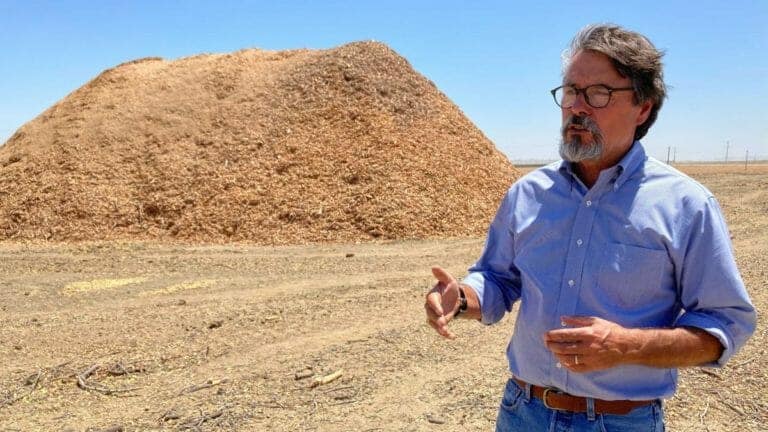Photo: Stuart Woolf stands near piles of almond tree wood chips that will get spread out on the his ranch. Caroline Champlin
When Stuart Woolf was growing up on his dad’s ranch in Huron, California, he never liked working the tomato harvest.
“I thought, ‘I am never going to do this.’ Everything was kind of wet, hot and stinky,” Woolf said.
These days, though, now as president of the 20,000-acre ranch, Woolf is prioritizing tomatoes over some of his other crops, like cotton and almonds, since they’re relatively less water-intensive.
With the drought desiccating California’s Central Valley, farmers like Woolf are having to reevaluate their business models based on how much water they can afford.
Besides growing tomatoes, Woolf also oversees a processing plant that turns them into an annual 350 million pounds of tomato paste. Inside the factory, the smell is sharp, like tomato stems, plus a faint hint of farm animals. Everywhere you look there are tanks, pipes and flumes. To Woolf, the water is precious.
“All the water in the plant ends up eventually going into the ranch,” Woolf said. “We’re collecting water from all over the place.”
Red streams of tomato-tinged water run into an underground pool. Then they get pumped back into the fields, soaking the ground for a future crop.
Kelsey Caratachea is a lab assistant at the plant who wears a white coat and looks more scientist than farmer. Her job is to check if the factory is extracting the most water out of the tomatoes as possible.
“I grab nine samples every hour,” Caratachea said.
She works with samples of ground-up tomato skin and seeds — what’s called pomace. These grainy tomato bits will just end up in dog food, but water left in is money lost.
“My results, I take them to the control room, and they make adjustments over there,” Caratachea said.
With the drought this year, Woolf’s access to extra water from other farmers has dried up. His tomatoes are relatively cheap waterwise, but his almonds are […]
Full article: Newsletters

